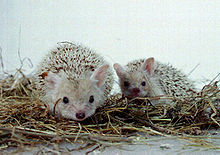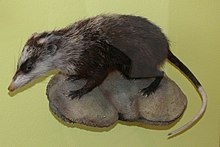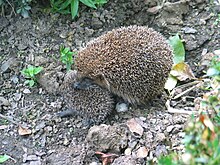Hedgehog
| Hedgehog | ||||||||||||
|---|---|---|---|---|---|---|---|---|---|---|---|---|

Northern white-breasted hedgehog ( Erinaceus roumanicus ) |
||||||||||||
| Systematics | ||||||||||||
|
||||||||||||
| Scientific name | ||||||||||||
| Erinaceidae | ||||||||||||
| Fisherman , 1814 |
The Hedgehog (Erinaceidae) form a family of mammals , the most famous representatives living in Europe species Hedgehog ( Erinaceus europaeus ) and northern white-breasted hedgehog ( Erinaceus roumanicus ) are. The brown-breasted hedgehog is the species typically found in western and central Europe . Across eastern central Europe (from western Poland via the Czech Republic , Austria to the northern Italian Adriatic coast ) there is an area of about 200 kilometers in which the range of the brown-breasted hedgehog stretches with that of the White-breasted hedgehogs overlapped.
In total, the family includes 26 species that are common in Eurasia and Africa . They are divided into two clearly different subfamilies, the prickly hedgehog (Erinaceinae) and the prickly rat or hairy urchin (Galericinae). The systematic position of the hedgehog is still controversial: It is discussed whether it belongs to the insectivores (Eulipotyphla) or a position as a separate order (Erinaceomorpha) at the base of the higher mammals (Eutheria), although recent studies make the former variant more likely.
etymology
Althochdeutsch igil (9th century), Middle High German hedgehog , Old Saxon igil , Middle Low German flukes , medium Dutch Eghel , Dutch egel , Old English igil , Old Norse īgull is as l related dissipation with the Greek echis (ἕχις) 'snake', from Indo-European * eĝhi - 'snake'.
The same Greek or Indo-European starting form includes with n -suffix Greek echinos (έχΐνος) , 'Igel, Seeigel ' and with Indo-European įo -suffix: Serbian-Church Slavonic ježь , Russian ёж , Lithuanian ežys 'hedgehog'.
All of these derivations are to be understood as 'snake animal, snake eater', since the hedgehog not only eats insects, frogs, mice etc. but also snakes.
features
General physique

|

|
|
|
Young hedgehog
|
Hedgehogs can curl up in case of threat
|
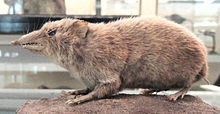
Hedgehogs are small to medium-sized animals. Their head-to-torso lengths vary from 10 to 45 centimeters. The hedgehog species with the largest and heaviest specimens is the large rat hedgehog with a weight of up to 2 kilograms. In contrast, specimens of the small rat hedgehog weigh 20 to 80 grams. The tail length of hedgehogs is variable, some representatives of the rat hedgehog have a long tail, while in the hedgehog it is usually only a short stub.
The limbs of the hedgehogs are relatively short and unspecialized. As with all insectivores , the thumbs or big toes cannot be opposed , the feet usually end in five toes with sharp claws - only the African hedgehogs have four toes on their hind feet. The tibia and fibula are fused as in many insectivores in the bottom half.
Hedgehogs are sole walkers . The back legs of the rat hedgehogs are a little longer than the front legs to allow a quick escape.
Coat

The fur of the hedgehog is usually kept in inconspicuous brown or gray tones. The hedgehogs have spikes on their backs and flanks as an effective defense weapon ( there are around six to eight thousand in the brown-breasted hedgehog ). These spines are modified, hollow hairs. Each sting is equipped with a righting muscle ( Musculus arrector pili ). Hedgehogs can curl up in a ball when threatened. The curling of the body is a complex interplay of numerous muscles, including the caudo-dorsalis muscle , which runs from the caudal vertebrae to the back and erects the spines, and a circular muscle ( sphincter cuculli muscle ), which keeps the ball closed and thus hides the unprotected parts of the body . The abdomen, the face and the limbs of the hedgehogs are covered with fur.
In contrast to this, rat hedgehogs have no spines and therefore (and because of their usually longer tail) give a more shrew- like impression. Their gray-brown to black fur can be silky-soft or rough, depending on the species. The defense strategy of these animals is flight .
Head and teeth

The hedgehog's skull is elongated and flat. A special feature is the closed zygomatic arch and the independent zygomatic bone , which distinguishes these animals from most other insectivores. The head sits on a short neck. The elongated, flexible snout is equipped with whiskers . The eyes and ears are - compared to other insectivores - relatively large. The sense of smell and hearing are probably the most important senses when searching for food, while visual perception only plays a subordinate role.
The skull is relatively small, so the brain is also simply built and small compared to the body mass. However, the olfactory bulb is well developed. The hedgehog also uses Jacobson's organ .
The hedgehog's teeth have pointed cusps and sharp melting strips and are very well adapted to their carnal diet . All species have a comparatively large number of teeth, with some representatives the original number of teeth 44 of the higher mammals has been preserved. The front incisor is often larger than the rest of the incisors, the upper molars have four cusps, the rear molar is often reduced.
| Tooth formula | I. | C. | P | M. | |
|---|---|---|---|---|---|
| 36-44 | = | 3 | 1 | 3-4 | 3 |
| 2-3 | 1 | 2-4 | 3 | ||
Digestive and reproductive tract
The digestive tract is very simply built. There is no appendix , the intestine is a simple tube and very short compared to the length of the body. In males, the testicles are always outside the abdominal cavity in scrotum- like skin folds, the cremaster folds . The females have a two-horned uterus .
distribution and habitat

Hedgehogs are restricted to the Old World , they are found in Europe , Africa, and parts of Asia . They are absent in America as well as in Australia . While the range of the hedgehog stretches from the British Isles and the Iberian Peninsula to South Africa or Korea and India , the hedgehogs are limited to Southeast Asia .
Hedgehogs inhabit a variety of habitats: the hedgehogs prefer dry habitats , they can be found in light forests, grasslands and cultural landscapes, among other things. Some genera such as the desert hedgehog and long-eared hedgehog are even distinct steppe and desert inhabitants. The rat hedgehogs, on the other hand, prefer moist habitats and are found primarily in rainforests.
The Australian ant urchins are not hedgehogs and are not closely related to them, but sting-bearing insectivores .
Way of life
General
Hedgehogs are primarily terrestrial (ground-living); mostly they look for food on the ground. Some species can climb well and sometimes hang out on bushes. Some species create trails in the dense undergrowth for faster progress. Some species can swim well. At least one species, the great rat hedgehog , also forages in water.
Hedgehog usually dig their own burrows , which serve as resting places. The entrances to the burrows are mostly hidden in dense vegetation, the nest is often lined with dry vegetation. Hedgehogs, on the other hand, usually do not build burrows, but hide between crevices in the rock, in the roots of trees or in holes in the ground.
Prickly hedgehogs curl up in a ball and straighten up their spines (see coat ).
Social behavior and activity times
Hedgehogs usually lead a solitary life outside of the mating season. They are predominantly crepuscular or nocturnal , only some species of the hedgehog are known to be able to forage during the day. Sick animals are noticed by aimlessly walking around during the day, infestation by parasites or apathetic behavior.
The hedgehogs in cooler regions hibernate , the inhabitants of very hot areas fall into a torpor (rigid state) during the dry periods .
food
Hedgehogs primarily eat invertebrates (for example insects and their larvae and annelids ), but also small vertebrates and carrion. Occasionally they will also eat plant material such as roots and fruits.
It is wrong to claim that hedgehogs store their food supplies on the spines. Although leaves or fruits are sometimes found impaled on their backs, the hedgehogs do not feed on them. They inadvertently pick up this ballast, for example in their nest, and show little zeal to remove it.
Hedgehogs are lactose intolerant and can not break down milk sugar . They drink milk that is offered to them by humans, for example, but can die from it.
Reproduction
Hedgehogs give birth once a year (twice in warmer regions). After a gestation period of around 30 to 48 days, the female throws up to eleven young animals (the average for European species is four to five). The young hedgehogs still have soft spines when they are born so as not to damage the mother's birth canal. Newborns are initially blind and helpless. The young animals open their eyes after 12 to 24 days, and after six to eight weeks they are weaned from their mother's milk . Sexual maturity usually occurs after 6 to 12 months. Life expectancy in the wild is - as far as is known - three to seven years.
Hedgehogs and people
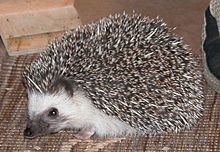
For reasons of folk medicine or superstition , some species of hedgehog were hunted; but they were never threatened with extinction. White-bellied dwarf hedgehogs are kept as pets in some places .
Hot dry summers in Europe (for example 2018 , 2019 and 2020, see also Global Warming # The ten warmest years ) promote the death of insects ; in many places the soils are dry and hard. The number of hedgehogs in Germany, Great Britain (the "motherland of hedgehog research") and other countries has declined significantly since the mid-1990s (or earlier). The use of pesticides also harms them.
The rainforest-dwelling rat hedgehogs are threatened by the deforestation of rainforests . The IUCN has two gymnure species as "critically endangered" ( endangered ) and one as "at risk" ( vulnerable classified).
see also Braunbrustigel # Braunbrustigel and Mensch
Systematics
External system
The systematic position of the hedgehog is one of the most controversial questions in the systematics of mammals. For a long time they were classified in the order of insectivores (Insectivora), which also includes shrews and moles . However, this order was only defined by relatively weak similarities, and groups were repeatedly incorporated or removed.
Since the beginning of the 21st century there have been some molecular genetic studies, for example of mitochondrial genes , according to which the hedgehogs are not closely related to the other insectivores, but rather form their own order ( Erinaceomorpha ). These studies placed the hedgehogs at the base of the higher mammals and saw them as the sister group of all other higher mammals.
However, there is criticism of these studies. In particular, mitochondrial DNA sequences in these animals have undergone rapid evolution with a high mutation rate and therefore differ genetically more strongly from their closest relatives than they do from more distant species. Subsequent analyzes, including those of nuclear genes, and also of mitochondrial genes, again confirmed that the hedgehogs belong to the insect eater. Even if this view is not undisputed, it is gaining more and more evidence.
According to these investigations, the closest relatives of the hedgehogs are the shrews , so within the insectivores the following cladogram results :
| Eulipotyphla ( insect eater ) |
|
||||||||||||||||||||||||
|
|
Internal system
The hedgehogs are divided into two subfamilies with a total of 10 genera and 24 species:
-
Rat hedgehog (Galericinae)
- Great rat hedgehog ( Echinosorex gymnura )
- Small rat hedgehog ( Hylomys ), three species
- Shrew hedgehog ( Neotetracus sinensis )
- Hainan's rat hedgehog ( Neohylomys hainansensis )
- Philippines rat hedgehog ( Podogymnura ), two species
-
Hedgehog (Erinaceinae)
- Small-ear hedgehog ( Erinaceus ), four species (including the two representatives living in Europe)
- African hedgehog ( Atelerix ), four species
- Steppe hedgehog ( Mesechinus ), four species
- Long-eared hedgehog ( Hemiechinus ), two species
- Desert hedgehog ( Paraechinus ), four species
The relationships within the family are shown in the following diagram:
| Hedgehog (Erinaceidae) |
|
||||||||||||||||||||||||||||||||||||||||||||||||
|
|
Tribal history
The fossil history of the hedgehog dates back to the Paleocene , the oldest known representative is the Litolestes from North America. The group of Amphilemuridae is known from North America and Europe , which already had very similar defense strategies to today's representatives. The genus Deinogalerix is known from Europe from the Miocene , a representative of the rat hedgehog, which probably weighed around ten kilograms. In the Pliocene the hedgehog in America are likely to be extinct.
literature
- Eckhard Grimmberger: The mammals of Germany. Observe and determine. Quelle & Meyer Verlag , Wiebelsheim 2014, ISBN 978-3-494-01539-2 , pp. 34-40 (order Igel-like).
- Hermann wood, Jochen Niethammer: Erinaceidae - hedgehogs. In: Jochen Niethammer, Franz Krapp (ed.): Handbook of Mammals in Europe. Volume 3/1: insectivores, master animals. AULA-Verlag , Wiesbaden 1990, ISBN 3-89104-027-X , pp. 20-74.
- Ronald M. Nowak: Walker's Mammals of the World. 2 volumes. 6th edition. Johns Hopkins University Press, Baltimore MD et al. 1999, ISBN 0-8018-5789-9 .
- Gerhard Storch : Lipotyphla, insect eater. In: Wilfried Westheide , Reinhard Rieger (Ed.): Special Zoology. Volume 2: Vertebrates or Skull Animals. Spektrum Akademischer Verlag, Heidelberg et al. 2004, ISBN 3-8274-0307-3 , pp. 514-524.
- Don E. Wilson , DeeAnn M. Reeder (Eds.): Mammal Species of the World . A taxonomic and geographic Reference. 2 volumes. 3. Edition. Johns Hopkins University Press, Baltimore MD 2005, ISBN 0-8018-8221-4 .
- Igel-Bulletin , magazine of the Pro Igel association
Movie
- The year of the hedgehog. (Alternative title: The mysterious world of the hedgehogs. ) Documentary, Austria, 2009, 44:20 min., Script and director: Kurt Mündl , production: ORF , series: Universum (TV series) , first broadcast: December 15, 2009 on ORF2 , synopsis by 3sat .
Web links
- Literature on the subject of hedgehogs in the catalog of the German National Library
- The hedgehog - prickly survivor (MP3; 19 MB) Podcast for the radioWissen broadcast on December 4, 2014 by Carola Zinner
Individual evidence
- ↑ Monika Neumeier: The Igel-Praxisbuch. Kosmos, Stuttgart 2006.
- ↑ Wolfgang Pfeifer : Etymological Dictionary of German (= dtv 32511). Unabridged, revised edition of the paperback edition, 5th edition. Deutscher Taschenbuch Verlag (dtv), Munich 2000, ISBN 3-423-32511-9 , p. 571.
- ↑ Igel im Herbst - Vier Pfoten gives tips for the correct handling , accessed on September 30, 2019 in Fellbeisser.net.
- ↑ Lactose intolerance in hedgehogs ( memento of the original from March 16, 2017 in the Internet Archive ) Info: The archive link was inserted automatically and has not yet been checked. Please check the original and archive link according to the instructions and then remove this notice.
- ↑ faz.net August 21, 2020: Hedgehogs starve and die of thirst
- ^ Hedgehogs in the IUCN Red List of Threatened Species . Retrieved November 9, 2009.
- ↑ Christophe J. Douady, Pascale I. Chatelier, Ole Madsen, Wilfried W. de Jong, Francois Catzeflis, Mark S. Springer, Michael J. Stanhope: Molecular phylogenetic evidence confirming the Eulipotyphla concept and in support of hedgehogs as the sister group to shrews. In: Molecular Phylogenetics and Evolution. Vol. 25, No. 1, 2002, ISSN 1055-7903 , pp. 200-209, doi : 10.1016 / S1055-7903 (02) 00232-4 .
- ↑ Masato Nikaido, Ying Cao, Masashi Harada, Norihiro Okada, Masami Hasegawa: Mitochondrial phylogeny of hedgehogs and monophyly of Eulipotyphla. In: Molecular Phylogenetics and Evolution. Vol. 28, No. 2, 2003, pp. 276-284.
- ↑ Based on Robin MD Beck, Olaf RP Bininda-Emonds, Marcel Cardillo, Fu-Guo Robert Liu, Andy Purvis: A higher-level MRP supertree of placental mammals. In: BMC Evolutionary Biology. Vol. 6, No. 93, 2006, ISSN 1471-2148 , doi : 10.1186 / 1471-2148-6-93 , PMC 1654192 (free full text).
